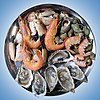Chicken as food



Chicken is the most common type of poultry around the world. It is prepared in a number ways, including boiling, baking, frying and grilling. Prepared chicken became a staple for fast food in the second half of the 20th century. Chicken is often said to be more healthful than red meat. It has less cholesterol and saturated fat.
Chicken as a meat first began in Babylonian carvings from around 600 BC.[1] Chicken was one of the most common meats available during the Middle Ages.[2]
In the United States in the 1800s, chicken was more expensive than other meats.[3] Chicken consumption in the United States increased during World War II due to there not being enough beef and pork. In Europe, chicken was more than that of beef and veal in 1996 because of the consumer awareness of mad cow disease.[4]
Modern varieties of chicken, like the Cornish Cross, are bred specifically for meat production. The most common breeds of chicken consumed in the United States are the White Rock and the Cornish.[5]
Chickens raised mainly for food are called broilers. In the United States, broilers are usually butchered at a young age.
Edible parts of a chicken
[change | change source]main
[change | change source]- Breast: These are white meat and are relatively dry. The breast has two segments which are sold together on bone-in breasts, but separated on boneless breasts:
- The "breast", when sold as boneless, and
- two "tenderloin", located on each side between the breast meat and the ribs. These are removed from boneless breasts and sold separately as tenderloins.[6]
- Leg: Comprises two segments:
- The "drumstick"; this is dark meat and is the lower part of the leg,
- the "thigh"; also dark meat, this is the upper part of the leg.
- Wing: Often served as a light meal or bar food. Buffalo wings are a typical example. Comprises three segments:
- the "drumette", shaped like a small drumstick, this is white meat,
- the middle "flat" segment, containing two bones, and
- the tip, often discarded.
Chicken meat has two to three times as much polyunsaturated fat as most types of red meat when measured as weight percentage.[7]
Related pages
[change | change source]References
[change | change source]- ↑ "The Chicken Facts and Origins". Poultrymad. Retrieved May 14, 2021.
- ↑ "Chicken Husbandry in Late Medieval Eastern England". Academia. Retrieved May 14, 2021.
- ↑ "How Chicken Conquered the American Dinner Plate". First We Feast. Archived from the original on May 15, 2021. Retrieved May 14, 2021.
- ↑ "BBC Survey Another Blow". Food Production Daily. Archived from the original on 2007-09-28. Retrieved May 14, 2021.
- ↑ "Focus on Chicken". The United States Department of Agriculture. Archived from the original on 2004-05-19. Retrieved May 14, 2021.
- ↑ "What is a Chicken Tenderloin?". 4thegrill.com. 25 February 2019. Archived from the original on 4 October 2021. Retrieved 7 April 2021.
- ↑ "Nutrition Fact Sheet". Northwestern University. Archived from the original on 2011-07-20. Retrieved May 14, 2021.
{{cite journal}}: Cite journal requires|journal=(help)

